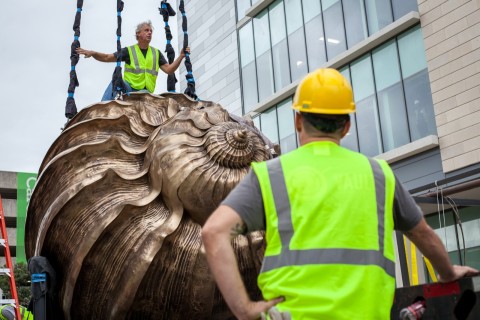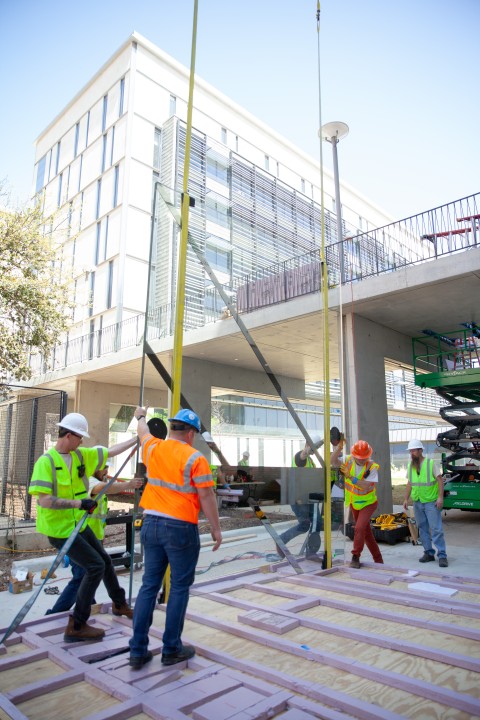As part of our ongoing celebrations for Landmark’s 15th anniversary, we’re starting a blog series that takes a closer look at the personalities who made it all possible. Highlighting some of the amazing people who have been integral to Landmarks’ success, we start with art installer and preparator Patrick Sheehy, whose talents have made the public art collection on campus a reality.
In 2008, Landmarks accepted 28 works on long-term loan from the Metropolitan Museum of Art. Sheehy and his team installed the works that established the foundation of the Landmarks collection. Among the group was Tony Smith’s Amaryllis, a black steel sculpture comprised of two geometric sections, bolted together from the inside.
“In Tony Smith fashion, whenever he puts anything together he uses more bolts than you could ever imagine,” said Sheehy, as he recalled having to climb inside the sculpture’s 24-inch cubby hole. During the installation, Sheehy worked from the inside while his team fit the work together from the outside – creating the illusion of one seamless sculpture. It was especially difficult considering the scorching July heat that the team worked under.

Sheehy began his career on campus more than 25 years ago, serving as head carpenter for The Archer M. Huntington Gallery, before it was renamed The Blanton Museum of Art. His background as a sculptor and degree from The Art Institute of Chicago prepared him with an unusual combination of skills that offered deep insights into the subtleties of art installation. After college he used his knowledge to begin building and making things for others. He constructed supports for a variety of artists while working with the Huntington and other organizations in Austin. Sheehy’s knowledge of materials and forms, and talent for working with artists, has made him uniquely adept at managing the most complex art installations.

Marc Quinn, installation of Spiral of the Galaxy, 2013. 20 October 2016.
Photo by photo by Lawrence Peart
Some of his more challenging contributions include the installation of Marc Quinn’s Spiral of the Galaxy, Landmarks’ multi-ton bronze sculpture on the Dell Medical School’s campus. Installing the work involved two cranes, an early morning start, and some road closures, which Sheehy notes were probably the most expensive part of the whole operation.
“I think Quinn’s Spiral of the Galaxy weighed 4 tons, so 8,000 to 10,000 pounds” said Sheehy, “It was pretty well engineered. They had hidden receivers in the top for eyelets, so we just attached our rigging to that, and picked it straight up.”

Sheehy and his team are typically involved a few months to a full year before a work comes to Landmarks. He is consulted on a range of things, including successful transportation, equipment needs, and on-site installation logistics. Sheehy has developed a shorthand with his team, some of whom have worked with him for more than ten years. This shorthand includes hand signals for crane movements, which came in handy during the installation of Sarah Oppenheimer’s C-010106. The piece is composed of two forms, each with four pieces of glass that are inserted into the Peyton Family Bridge at the Cockrell School of Engineering. It was fabricated in Germany and transported to the U.S., requiring onsite assembly with a crane and took two weeks to install
When the work arrived in Austin, it had never been assembled before. Sheehy recalls his apprehension about putting the pieces together for the first time: “The metal was fabricated in New York and the glass was fabricated in Germany, and they had never met before, and that's pretty sketchy” said Sheehy, “but as it turned out, with modern technology, everything fit together as it should have.”
Other challenging aspects began before the works were uncrated. “When we delivered the crates, the wind was super intense, and that night we actually had a tornado touchdown in North Austin” recalled Sheehy. “We had done all of this bracing to make sure these crates didn't move, and everything went well, but it was just an eye opener to know the intensity of the elements we were dealing with.”
Not all of Sheehy’s installations have been so intense, but they typically aren’t any less taxing. This includes installing Sol LeWitt’s Wall Drawing #520 which necessitated a team of 8 people that Sheehy recruited and oversaw during a 30-day installation period in 2013. The wall drawing is composed of transparent ink washes applied directly to the wall. Its array of colors produce a litany of hues as determined by LeWitt in his original instructions for the work.
“For the install I had to find ‘artist types’ that worked as waiters or waitresses to apply the paint because they were the only people that had the flexibility to work for 30-days in a row” said Sheehy. “We had breaks of course, but each block of color took approximately 25 to 30 coats.”

Watch a timelapse of Wall Drawing #520 being installed here.
Sheehy and his team have worked on almost every Landmarks’ project, successfully navigating a broad range of challenges. We invite you to visit the collection in person and consider what it takes to bring objects like a multi-ton shell or penny-covered buoys to campus. Stay tuned for additional blogs in this series as we celebrate the past 15 years!
Love public art? Consider making a donation now to support art on campus.
